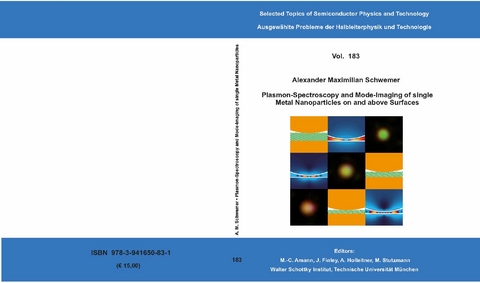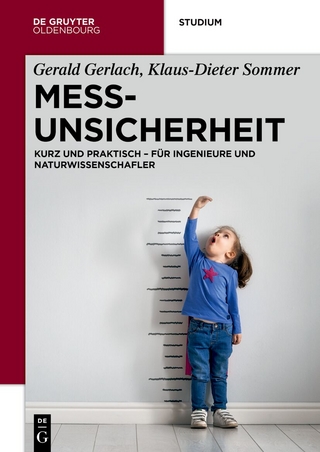Plasmon-Spectroscopy and Mode-Imaging of single Metal Nanoparticles on and above Surfaces
Seiten
2014
Verein zur Förderung des Walter Schottky Instituts der Technischen Universität München (Verlag)
978-3-941650-83-1 (ISBN)
Verein zur Förderung des Walter Schottky Instituts der Technischen Universität München (Verlag)
978-3-941650-83-1 (ISBN)
- Titel ist leider vergriffen;
keine Neuauflage - Artikel merken
In this doctoral thesis the light-scattering properties of single nanoparticles are in- vestigated with plasmon-spectroscopy and mode-imaging. The plasmonic modes of a nanoparticle are strongly influenced by their the distance to other metal nanostructures and on their geometry. These influences manifest in shifts of the resonance frequency and altered shape of particle’s far-field image. Both effects are extremely sensitive to variations on the sub-nanometer-scale.
The first part of this thesis investigates the plasmonic coupling of a spherical, metallic nanoparticle with a metallic surface. It is found that at distance-to-radius ratios below 0.5 new plasmonic modes arise in the nano-system. With decreasing distance to the surface up to four plasmonic modes are observed while they simultaneously shift to lower energies. At the same time the far-field image of the sphere-surface- system alters its shape from point-like to annular. These effects are investigated experimentally and theoretically.
The Quasi Static Dipole Approximation (QSDA), the Generalized Multi-particle Mie- theory (GMM) and the Finite Difference Time Domain (FDTD) simulation method are applied to calculate the scattering properties of the sphere-surface system. While the analytical calculations of the QSDA and GMM cannot describe the scattering spectrum sufficiently well for such small distances, the FDTD simulations show more modes evolving the closer the particles gets to the surface.
The corresponding experiments are conducted with spherical gold particles (40 nm diam.) which are separated between 1 nm and 8 nm from a thin gold film. The distance is controlled with self-assembled monolayers (SAM) out of carbon chain molecules immobilized on the film. Additionally, a coating with Streptavidin mo- lecules on the particle is used to increase the spacing. The high sensitivity of the particle’s resonances to its precise distance to the surface makes it possible to dis- criminate SAMs of different thicknesses in a sub-nanometer resolution. The experi- mental findings are in good agreement with the FDTD calculations.
This high sensitivity also manifests itself as soon as flexible or compressible mole- cules are involved for spacing. An increased variation between single particles on the identical SAM are observed. This can be exploited to induce a distance modula- tion by electrically charging the surface and with that dragging or repelling charged particles from or to the surface. In doing so the flexible molecules get compressed or stretched out. This non-destructive and repeatable distance alteration is observed via the resonance shift of the plasmonic modes of the particle.
In the second part random patterns of nano-rods on dielectric substrates are inves- tigated and how they can be applied as secure labels in physical cryptography. In gold nanorods two plasmonic modes with different resonance frequencies exist ac- cording to their long and short axis of the rod-like geometry. Solely with imaging techniques, the lateral position and orientation are read-out rapidly. Here, the posi- tion is read-out with a sub-nanometer and the orientation with a sub-degree resolu- tion for each nanorod. With a number of particles on a label, this gives a unique data set which proves the identity of the item with which is labeled. The randomness at the nanometer-scale makes the label impossible to forgery in the near future.
The first part of this thesis investigates the plasmonic coupling of a spherical, metallic nanoparticle with a metallic surface. It is found that at distance-to-radius ratios below 0.5 new plasmonic modes arise in the nano-system. With decreasing distance to the surface up to four plasmonic modes are observed while they simultaneously shift to lower energies. At the same time the far-field image of the sphere-surface- system alters its shape from point-like to annular. These effects are investigated experimentally and theoretically.
The Quasi Static Dipole Approximation (QSDA), the Generalized Multi-particle Mie- theory (GMM) and the Finite Difference Time Domain (FDTD) simulation method are applied to calculate the scattering properties of the sphere-surface system. While the analytical calculations of the QSDA and GMM cannot describe the scattering spectrum sufficiently well for such small distances, the FDTD simulations show more modes evolving the closer the particles gets to the surface.
The corresponding experiments are conducted with spherical gold particles (40 nm diam.) which are separated between 1 nm and 8 nm from a thin gold film. The distance is controlled with self-assembled monolayers (SAM) out of carbon chain molecules immobilized on the film. Additionally, a coating with Streptavidin mo- lecules on the particle is used to increase the spacing. The high sensitivity of the particle’s resonances to its precise distance to the surface makes it possible to dis- criminate SAMs of different thicknesses in a sub-nanometer resolution. The experi- mental findings are in good agreement with the FDTD calculations.
This high sensitivity also manifests itself as soon as flexible or compressible mole- cules are involved for spacing. An increased variation between single particles on the identical SAM are observed. This can be exploited to induce a distance modula- tion by electrically charging the surface and with that dragging or repelling charged particles from or to the surface. In doing so the flexible molecules get compressed or stretched out. This non-destructive and repeatable distance alteration is observed via the resonance shift of the plasmonic modes of the particle.
In the second part random patterns of nano-rods on dielectric substrates are inves- tigated and how they can be applied as secure labels in physical cryptography. In gold nanorods two plasmonic modes with different resonance frequencies exist ac- cording to their long and short axis of the rod-like geometry. Solely with imaging techniques, the lateral position and orientation are read-out rapidly. Here, the posi- tion is read-out with a sub-nanometer and the orientation with a sub-degree resolu- tion for each nanorod. With a number of particles on a label, this gives a unique data set which proves the identity of the item with which is labeled. The randomness at the nanometer-scale makes the label impossible to forgery in the near future.
| Sprache | englisch |
|---|---|
| Einbandart | Paperback |
| Themenwelt | Naturwissenschaften ► Physik / Astronomie |
| Schlagworte | Plasmon Coupling • single-metal nanoparticles • Thin film |
| ISBN-10 | 3-941650-83-1 / 3941650831 |
| ISBN-13 | 978-3-941650-83-1 / 9783941650831 |
| Zustand | Neuware |
| Haben Sie eine Frage zum Produkt? |
Mehr entdecken
aus dem Bereich
aus dem Bereich
von den Werkzeugen über Methoden zum TQM
Buch | Softcover (2024)
Springer Fachmedien (Verlag)
32,99 €
kurz und praktisch - für Ingenieure und Naturwissenschafler
Buch | Softcover (2024)
De Gruyter Oldenbourg (Verlag)
44,95 €




